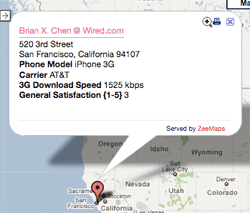 AT&T may have played no part in Apple’s rejection infinite pondering of Google’s Google Voice app for iPhone, but that doesn’t mean that the phone carrier is a Google Voice fan. Far from it, apparently–the company has written a letter to the FTC complaining about Google Voice’s blocking of certain phone numbers operated by rural carriers (including adult services) for which it would otherwise have to pay unusually high fees to the rural phone companies. As a common carrier, AT&T is required to put these calls through even though they cost the company hundreds of millions of dollars a year.
AT&T may have played no part in Apple’s rejection infinite pondering of Google’s Google Voice app for iPhone, but that doesn’t mean that the phone carrier is a Google Voice fan. Far from it, apparently–the company has written a letter to the FTC complaining about Google Voice’s blocking of certain phone numbers operated by rural carriers (including adult services) for which it would otherwise have to pay unusually high fees to the rural phone companies. As a common carrier, AT&T is required to put these calls through even though they cost the company hundreds of millions of dollars a year.
Here’s AT&T’s letter in its entirety:
AT&T argues that (A) Google Voice is essentially similar to traditional phone service and so should play by the same rules; (B) even if you consider it to be an application rather than phone service, FCC policy says that consumers are entitled to competition among networks, applications and services, and it’s not fair competition if Google Voice has an advantage; and (C) by blocking certain calls that would cost it a lot of money to connect, Google is violating the philosophy of net neutrality which it’s famous for enthusiastically supporting.
Google has speedily published a blog post responding to AT&T’s complaints. The gist: (A) Google Voice is a free application and therefore not required to follow common-carrier rules or basically listen to the FCC at all; (B) it’s not a replacement for a traditional phone service such as that offered by AT&T; and (C) it’s still in private beta.
I’m no expert on telecommunications policy. But to my layman’s ears, neither company’s argument is instantly compelling. AT&T’s letter is dripping with needless, grating snark (it’s not often that you see one large company accuse another of being “noisome” in a public venue). It doesn’t explain why it thinks its services and Google Voice are largely similar given that Google Voice is a sort of overlay for traditional phone service rather than a replacement for it. And wasn’t AT&T just insisting that net neutrality policy shouldn’t apply to wireless service, thereby undercutting its new stance that if there’s going to be net neutrality, it must be observed uniformly?
Google, meanwhile, doesn’t actually explain why it’s reasonable that Google Voice should play by different rules than AT&T–it just says that it does. Nor does it spell out why it thinks that the fact that Google Voice is free and (currently) only available in a limited fashion are germane to the discussion at hand.
Google does extend an olive branch of sorts by stating that it thinks the FCC rules that leave AT&T and other common carriers paying through the nose for these rural phone company services should be reformed. Maybe that’s the ultimate solution here: Prevent the little phone companies from gouging the big ones for porn calls. As a customer of AT&T who uses Google Voice, I know where my self-interest lies: I want the two companies’ services to work well together, and for Google Voice to retain its attractive current price ($0.00 a month).
Are you taking sides in this squabble?

 Wired.com, which published an
Wired.com, which published an  I’m having a very good time at the
I’m having a very good time at the